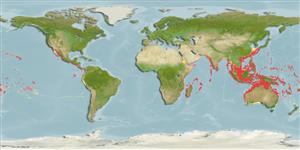>
Acanthuriformes (Surgeonfishes) >
Zanclidae (Moorish idol)
Etymology: Zanclus: Greek, za = an augmentative particle + Greek, agklino = to be on one´s back (Ref. 45335).
More on author: Linnaeus.
Environment: milieu / climate zone / depth range / distribution range
पारिस्थितिकी
समुद्री प्रवाल-भित्ति संयुक्त; गहराई सीमा 0 - 182 m (Ref. 9710), usually 5 - 182 m (Ref. 27115). Subtropical; 24°C - 28°C (Ref. 27115); 32°N - 37°S, 21°E - 70°W
Indo-Pacific: East Africa to Rapa and Ducie islands, north to southern Japan and the Hawaiian Islands, south to the Lord Howe Island. Eastern Pacific: southern Gulf of California to Peru (Ref. 9267).
आकार / वज़न / Age
Maturity: Lm ? range ? - ? cm
Max length : 23.0 cm TL पुल्लिंग / अलिंग; (Ref. 6113); common length : 21.0 cm NG पुल्लिंग / अलिंग; (Ref. 5755)
पृष्ठीय रीढ़ (सम्पूर्ण) : 6 - 7; पृष्ठीय सौफट रेज़ (सम्पूर्ण) : 39 - 43; गुदा कांटा: 3; ऐनल सौफट रेज़: 31 - 37. Strongly compressed discoid body. Tubular snout with a small mouth containing numerous elongate bristle-like teeth. Dorsal spines elongated into a whip-like filament.
Inhabit turbid inner lagoons, reef flats, and clear seaward rocky and coral reefs (Ref. 1602, 48637). Benthopelagic (Ref. 58302). Generally encountered in small groups of 2 or 3 individuals (Ref. 9267). Adults occur singly, in pairs and occasionally are seen in large schools (Ref. 48637). Feed on small encrusting animals (Ref. 6113). Size of metamorphosis from postlarva to juvenile is 7.5 cm (Ref. 9267). The long pelagic larval stage is the reason for the wide distribution and strong colouration that shows no geographical variation (Ref. 48637). Popular aquarium fish but rarely survives in tanks (Ref. 1602). Minimum depth reported taken from Ref. 128797.
Life cycle and mating behavior
Maturities | पुनरुत्पत्ति | Spawnings | Egg(s) | Fecundities | लार्वा
Myers, R.F., 1991. Micronesian reef fishes. Second Ed. Coral Graphics, Barrigada, Guam. 298 p. (Ref. 1602)
IUCN Red List Status (Ref. 130435)
Threat to humans
Harmless
Human uses
मात्स्यिकी: निर्वाह मात्स्यिकी; जलजीवालय: व्यापारिक
साधन
Special reports
Download XML
इंटरनेट स्रोत
Estimates based on models
Preferred temperature (Ref.
123201): 20 - 29, mean 27.7 °C (based on 4016 cells).
Phylogenetic diversity index (Ref.
82804): PD
50 = 1.5000 [Uniqueness, from 0.5 = low to 2.0 = high].
Bayesian length-weight: a=0.01738 (0.00674 - 0.04483), b=3.06 (2.84 - 3.28), in cm total length, based on LWR estimates for this (Sub)family-body shape (Ref.
93245).
Trophic level (Ref.
69278): 2.5 ±0.00 se; based on food items.
Fishing Vulnerability (Ref.
59153): Low vulnerability (13 of 100).
Nutrients (Ref.
124155): Calcium = 44.8 [19.5, 73.0] mg/100g; Iron = 0.697 [0.404, 1.262] mg/100g; Protein = 18.8 [17.5, 20.0] %; Omega3 = 0.175 [0.095, 0.315] g/100g; Selenium = 22.8 [10.2, 47.4] μg/100g; VitaminA = 29.5 [6.8, 126.5] μg/100g; Zinc = 1.05 [0.66, 1.62] mg/100g (wet weight);
